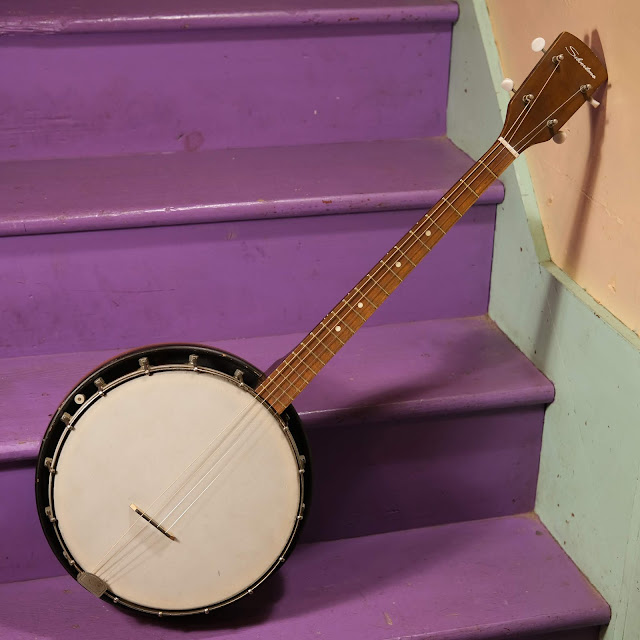1960s Kay-made Silvertone Resonator Tenor Banjo
Last year, I sold an almost-identical Kay-made tenor banjo that had the "Supro" brand at the headstock. This one bears the Sears Silvertone name instead but still has the cool, yellow-brown faded/sunburst finish throughout.
Kay made this style of tenor banjo from the late '30s through the late '60s, though this one clocks-in around the very early '60s. It has a simple build with a ply rim and hoop tonering. This yields a plunky, direct voice that suits folksy strumming or crosspicking and sounds particularly decent fingerpicked in a bluesy style.
The '60s-era versions of this banjo (like this one) have a slimmer neck than average and came stock with a Remo synthetic head and plastic nut, rather than skin and bone. While this neck has just a hair of relief on the treble side when tuned to pitch, I prefer the feel of this neck to the bigger, earlier-variant neck type as it reminds me a lot of '30s or '40s Gibson tenor banjos -- it's quick and makes pulling-off sliding chords a lot easier. That's personal taste, however, as I know plenty of folks who like the extra bulk for bracing their hands.
Repairs included: a fret level/dress, much cleaning, adjustment to the coordinator rod setup so it functions like a Gibson single-rod setup, a new anchor-bolt for the neck to lock its position in place on the adjustable-neck-gizmo-bracket, side dots install, and setup.
Setup notes: it plays beautifully with 1/16" action at the 12th fret. The neck has a hair of relieve (~1/64") on the treble side but is perfectly straight on the bass. It's a non-issue.
Scale length: 23"
Nut width: 1 1/8"
String spacing at nut: 7/8"
String spacing at bridge: 1 3/8"
Head diameter: 11"
Resonator diameter: 12 3/4"
Resonator diameter: 12 3/4"
Rim depth: 3 1/4"
Rim material: ply hardwood of some sort (maple? birch?)
Neck wood: poplar with steel reinforcement rod
Fretboard: economy-grade rosewood(?)
Bridge: Grover Leader 2-foot ebony/maple 1/2"
Neck feel: slim C-shape, flat board
Condition notes: there's minor wear throughout with any number of small, insignificant, light scratches. It's nice to see an instrument so original, though, too -- right down to everything except a replacement bridge.















Comments